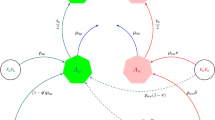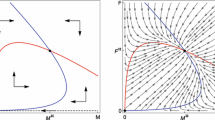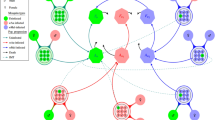Abstract
Laboratory and field tests have been highlight the importance of choosing an optimal Wolbachia strain to ensure the success of colonization and persistence of the released Aedes aegypti infected mosquito. Thresholds for vertical infection transmission and male sterilization depend on bacterial density and its distribution in mosquitoes tissue, which also affects strongly mosquito fitness. Temperature variation during mosquito development phase is an important factor that can affect the feasibility of this novel technique to control dengue transmission. In this context, a mathematical model is proposed to assess the factibility of dengue control transmission using a transinfection of A. aegypti with a Wolbachia strain. This model takes the form of a delay-differential system with two delays. The strength of this approach is measured by the fact that it can address several aspects of the problem, through scenarios construction where model parameters are setting according to mosquito genetic background, its ability to transmit the bacteria to the next generation, and its competence to block virus replication. The persistence of both infected and wild population is explored in the context of mosquito’s fitness, host-symbiont interaction, and temperature change. Surprisingly, the model predicts that mosquito population extinction can occur in a region of the parameter space where the reproductive number of the wild population is bigger than one and migration of mosquitoes from surrounding areas is not allowed.







Similar content being viewed by others
References
Ant TH, Herd CS, Geoghegan V, Hoffmann AA, Sinkins SP (2018) The Wolbachia strain wAu provides highly efficient virus transmission blocking in Aedes aegypti. PLOS Pathogens. https://doi.org/10.1371/journal.ppat.1006815
Axford JK, Ross PA, Yeap HL, Callahan AG, Hoffmann AA (2016) Fitness of wAlbB Wolbachia infection in Aedes aegypti: parameter estimates in an outcrossed background and potential for population invasion. Am J Trp Med Hyg 94:507–16
Bordenstein SR, Bordenstein SR (2011) Temperature affects the tripartite interactions between bacteriophage WO, Wolbachia, and cytoplasmic incompatibility. PLoS ONE 6:e29106
Caragata EP, Dutra HL, Moreira LA (2016) Inhibition of Zika virus by Wolbachia in Aedes aegypti. Microb Cell 3:293–5
Clark ME, Veneti Z, Bourtzis K, Karr TL (2003) Wolbachia distribution and cytoplasmic incompatibility during sperm development: the cyst as the basic cellular unit of CI expression. Mech Dev 120:185–198
Dye C (1984) Models for the population dynamics of the yellow fever mosquito, Aedes aegypti. J Anim Ecol 53:247–268
Farkas JZ, Hinow P (2010) Structured and unstructured continuous models for Wolbachia infections. Bull Math Biol 72:2067–2088. https://doi.org/10.1007/s11538-010-9528-1
Farkas JZ, Gourley SA, Liu R, Yakubu AA (2017) Modelling Wolbachia infection in a sex-structured mosquito population carrying West Nile virus. J Math Biol 75:621–647. https://doi.org/10.1007/s00285-017-1096-7
Ferguson NM, Kien DTH, Clapham H, Aguas R, Trung VT, Chau TNB, Popovici J, Ryan PA, O’Neill SL, McGraw EA, Long VT, Dui LT, Nguyen HL, Chau NVV, Wills B, Simmons CP (2015) Modeling the impact on virus transmission of Wolbachia-mediated blocking of dengue virus infection of Aedes aegypti. Sci Transl Med. 7, https://doi.org/10.1126/scitranslmed.3010370
Ferreira CP, Lyra SP, Azevedo F, Greenhalgh D, Massad E (2017) Modelling the impact of the long-term use of insecticide-treated bed nets on Anopheles mosquito biting time. Malar J 16:373
Hoffmann AA, Montgomery BL, Popovici J, Iturbe-Ormaetxe I, Johnson PH, Muzzi F, Greenfield M, Durkan M, Leong YS, Dong Y, Cook H, Axford J, Callahan AG, Kenny N, Omodei C, McGraw EA, Ryan PA, Ritchie SA, Turelli M, O’Neill SL (2011) Successful establishment of Wolbachia in Aedes populations to suppress dengue transmission. Nature 476:454–7
Hoffmann AA (2014) Facilitating Wolbachia invasions. Aust Entomol 53:125–32
Hoffmann A, Ross PA, Rasić G (2015) Wolbachia strains for disease control: ecological and evolutionary considerations. Evol Appl 8:751–68
Hu L, Huang M, Tang M, Yu J, Zheng B (2015) Wolbachia spread dynamics in stochastic environments. Theor Popul Biol 106:32–44
Hughes H, Britton NF (2013) Modelling the use of Wolbachia to control dengue fever transmission. Bull Math Biol 75:796–818
Iannelli M, Pugliese A (2014) An introduction to mathematical population dynamics. Spring ISBN 978-3-319-03026-5
Lee SS, Backer RE, Gaffney EA, White SM (2013) Optimal barrier zones for stopping the invasion of Aedes aegypti mosquitoes via transgenic or sterile insect techniques. Theor Ecol 6(4):427–442. https://doi.org/10.1007/s12080-013-0178-4
Marino S, Hogue IB, Ray CJ, Kirschner DE (2008) A methodology for performing global uncertainty and sensitivity analysis in systems biology. J Theor Biol 254:178–96
McMeniman CJ, Lane AM, Fong AWC, Voronin DA, Iturbe-Ormaetxe I, Yamada R, McGraw EA, O’Neill1 SL (2008) Host adaptation of a Wolbachia strain after long-term serial passage in mosquito cell lines. Appl Environ Microbiol 74:6963–69
McMeniman CJ, Lane RV, Cass BN, Fong AWC, Sidhu M, Wang Y, O’Neill SL (2009) Stable introduction of a life-shortening Wolbachia infection into the mosquito Aedes aegypti. Science 323:141–4
Pates H, Curtis C (2005) Mosquito behavior and vector control. Ann Rev Entomol 50:53–70
Kamtchum-Tatuene J, Makeoeace BL, Benjamin L, Baylis M, Solomon T (2017) The potential role of Wolbachia in controlling the transmission of emerging human arboviral infections. Curr Opin Infect Dis 30:108–16
Keeling MJ, Jiggins FM, Read JM (2003) The invasion and coexistence of competing Wolbachia strains. Heredity 91:382–8
Reynolds KT, Thomson LJ, Hoffmann AA (2003) The effects of host age, host nuclear background and temperature on phenotypic effects of the virulent Wolbachia strain popcorn in Drosophila melanogaster. Genetics 164:1027–34
Ritchie SA, Townsend M, Paton CJ, Callahan AG, Hoffmann AA (2015) Application of wMelPop Wolbachia strain to crash local populations of Aedes aegypti. PLOS Neglected Tropical Diseases, https://doi.org/10.1371/journal.pntd.0003930
Ruang-Areerate T, Kittayapong P (2006) Wolbachia transinfection in Aedes aegypti: a potential gene driver of dengue vectors. PNAS 103, https://doi.org/10.1073/pnas.0508879103
Turelli M (2009) Cytoplamic incompatibility in populations with overlapping generations. Evolution 64:232–41
Ulrich JN, Beier JC, Devine GJ, Hugo LE (2016) Heat sensitivity of wMel Wolbachia during Aedes aegypti development. PLoS Negl Trop Dis 10:e0004873. https://doi.org/10.1371/journal.pntd.0004873
van den Hurk AF, Hall-Mendelin S, Pyke AT, Frentiu FD, McElroy K, Day A, Higgs S, O’Neill SL (2012) Impact of Wolbachia on infection with Chikungunya and yellow fever viruses in the mosquito vector Aedes aegypti. PLoS Negl Trop Dis 6(11):e1892. https://doi.org/10.1371/journal.pntd.0001892
Veneti Z, Clark ME, Karr TL, Savakis C, Bourtzis K (2004) Heads or tails: host-parasite interactions in the Drosophila-Wolbachia system. Appl Environ Microbiol 70:5366–72
Viana-Medeiros PF, Bellinato DF, Martins AJ, Valle D (2017) Insecticide resistance, associated mechanisms and fitness aspects in two Brazilian Stegomyia aegypti (= Aedes aegypti) populations. Med Vet Entomol 31:340–50
Yang HM, Macoris MLG, Galvani KC, Andrighetti MTM, Wanderley DMV (2009) Assessing the effects of temperature on the population of Aedes aegypti, the vector of dengue. Epidemiol Infect 137:1188–202
Walker T, Johnson PH, Moreira LA, Iturbe-Ormaetxe I, Frentiu FD, McMeniman CJ, Leong YS, Dong Y, Axford J, Kriesner P, Lloyd AL, Ritchie SA, O’Neill SL, Hoffmann AA (2011) The wMel Wolbachia strain blocks dengue and invades caged Aedes aegypti populations. Nature 475, https://doi.org/10.1038/nature10355
Yang HM, Ferreira CP (2008) Assessing the effects of vector control on dengue transmission. Appl Math Comput 198:401–13
Yeap HL, Mee P, Walker T, Weeks AR, O’Neill SL, Johnson P, Ritchie SA, Richardson KM, Doig C, Endersby NM, Hoffmann AA (2011) Dynamics of the ‘Popcorn’ Wolbachia infection in outbred Aedes aegypti: informs prospects for mosquito vector control. Genetics 187:583–95
Xi Z, Khoo CCH, Dobson SL (2005) Wolbachia establishment and invasion in an Aedes aegypti laboratory population. Science 310:326–8
Zheng B, Tang M, Yu J (2014) Modeling Wolbachia spread in mosquitoes through delay differential equations. J Appl Math 74:743–770
Acknowledgments
I also would like to thanks Pejman Rohani, Mostafa Adimy, and the two anonymous reviewers for the comments that helped to improve the discussion present in this work. This work was done during a sabbatical year at Odum School of Ecology & Department of Infectious Diseases, University of Georgia, Athens, GA, USA.
Funding
CPF thanks grants 16/23738-3 and 18/24058-1, São Paulo Research Foundation (FAPESP).
Author information
Authors and Affiliations
Corresponding author
Rights and permissions
About this article
Cite this article
Ferreira, C.P. Aedes aegypti and Wolbachia interaction: population persistence in an environment changing. Theor Ecol 13, 137–148 (2020). https://doi.org/10.1007/s12080-019-00435-9
Received:
Accepted:
Published:
Issue Date:
DOI: https://doi.org/10.1007/s12080-019-00435-9




